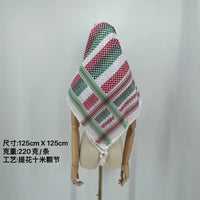The keffiyeh, also known as kufiya, ghutra, shemagh, or hatta, is more than just a traditional Middle Eastern headdress; it is a symbol of cultural identity, resistance, and solidarity. But who invented the keffiyeh? This article delves into the origins, evolution, and significance of this iconic scarf.
The Ancient Origins of the Keffiyeh
The keffiyeh's history dates back thousands of years. It is believed to have originated among the Sumerians and Babylonians in Mesopotamia around 3100 BCE. Sumerian priests wore a version of the keffiyeh to signify honor and rank within their society. The term "keffiyeh" itself is derived from the city of Kufa in Iraq, indicating its deep-rooted historical significance in the region.

Evolution Through the Ages
Practical Beginnings
Initially, the keffiyeh served a practical purpose. Bedouin tribes and Palestinian farmers wore it to protect themselves from the harsh desert sun, sandstorms, and cold weather. The scarf's design—a square piece of cloth typically made of cotton—was ideal for shielding the face and neck from the elements.
Symbol of Resistance
The keffiyeh's transformation from a practical garment to a symbol of resistance began during the British Mandate of Palestine in the 1930s. Palestinian rebels used the keffiyeh to conceal their identities during protests. When British authorities attempted to ban the keffiyeh, Palestinians wore it en masse as an act of defiance and unity.
Political Symbolism
The keffiyeh gained further prominence in the 1960s when Yasser Arafat, the leader of the Palestine Liberation Organization (PLO), adopted it as his signature headwear. Arafat's keffiyeh was always meticulously arranged to resemble a map of pre-1948 Palestine, symbolizing the Palestinian struggle for liberation. During the first and second intifadas, the keffiyeh became a powerful emblem of Palestinian nationalism and resistance.

The Keffiyeh in Modern Times
Global Symbol of Solidarity
Beyond the Middle East, the keffiyeh has become a global symbol of solidarity and resistance. Activists and supporters of the Palestinian cause worldwide don the keffiyeh to express their support. This international recognition has transformed the keffiyeh into a potent emblem of the broader fight against oppression.
Fashion Statement
In recent years, the keffiyeh has also made its mark in the fashion world. Designers and brands have incorporated keffiyeh-inspired patterns into their collections, sparking conversations about cultural appropriation and the importance of respecting its origins. While this trend has introduced the keffiyeh to a wider audience, it has also raised concerns about the commercialization and potential dilution of its symbolic meaning.

Conclusion
The keffiyeh is not just a piece of fabric; it is a timeless symbol of unity, resistance, and cultural identity. From its ancient origins in Mesopotamia to its role in the Palestinian struggle for liberation, the keffiyeh embodies the resilience and determination of its wearers. As it continues to evolve in response to changing times, it remains a potent emblem of solidarity with the Palestinian cause and the broader fight against oppression.





